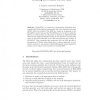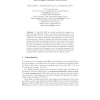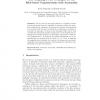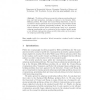PKC
2005
Springer
14 years 5 months ago
2005
Springer
RSA-KEM is a popular key encapsulation mechanism that combines the RSA trapdoor permutation with a key derivation function (KDF). Often the details of the KDF are viewed as orthogo...
PKC
2005
Springer
14 years 5 months ago
2005
Springer
To sign with RSA, one usually encodes the message m as µ(m) and then raises the result to the private exponent modulo N. In Asiacrypt 2000, Coron et al. showed how to build a secu...
PKC
2005
Springer
14 years 5 months ago
2005
Springer
PKC
2005
Springer
14 years 5 months ago
2005
Springer
We answer the open question of the possibility of building a digital signature scheme with proven security based on the one-wayness of a trapdoor permutation and with signatures as...
PKC
2005
Springer
14 years 5 months ago
2005
Springer
Abstract. We define and discuss symmetric subgroup membership problems and their properties, including a relation to the Decision DiffieHellman problem. We modify the Cramer-Shoup...
PKC
2005
Springer
14 years 5 months ago
2005
Springer
The Miller-Rabin pseudo primality test is widely used in cryptographic libraries, because of its apparent simplicity. But the test is not always correctly implemented. For example ...
PKC
2005
Springer
14 years 5 months ago
2005
Springer
PKC
2005
Springer
14 years 5 months ago
2005
Springer
Hidden field equation (HFE) multivariable cryptosystems were first suggested by Patarin. Kipnis and Shamir showed that to make the cryptosystem secure, a special parameter D of a...
PKC
2005
Springer
14 years 5 months ago
2005
Springer




